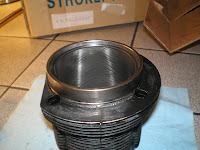
Due to their higher operating temperatures, in air cooled engines the piston ring gap is wider than on liquid-cooled engines. For after-market Volkswagen cylinders you want a minimum ring gap equal to 0.0045" per inch of bore. The jugs shown in these articles have a bore of 94mm - - about 3.7" in diameter. 3.7 x .0045 = .01665. Maximum would be about .005" per inch of bore or about .0185" but you could go as large as .006" per inch - - about .022" - - before you began to see a decline in performance.
What cannot be allowed is a gap that is too small. That is, our negative tolerance is zero, meaning the gap can’t be any smaller than our nominal .017" although our positive tolerance could be as much as .005". Written out it would look like this:
RING GAP = 0.017, -0 / +.005
 Select a cylinder. Wipe the bore dry using a paper tower (*). Find the baggie matching that cylinder’s number. Lay-out the piston rings and wipe them dry. Starting with the Upper Compression ring, gently stone the edges of its gap. Use your 3x loupe to inspect your work. It should take only two or three light passes of the stone to break the sharp edges of the gap. Repeat this procedure for all four rings for that particular cylinder. After stoning, wipe the edges with a clean paper towel.
Select a cylinder. Wipe the bore dry using a paper tower (*). Find the baggie matching that cylinder’s number. Lay-out the piston rings and wipe them dry. Starting with the Upper Compression ring, gently stone the edges of its gap. Use your 3x loupe to inspect your work. It should take only two or three light passes of the stone to break the sharp edges of the gap. Repeat this procedure for all four rings for that particular cylinder. After stoning, wipe the edges with a clean paper towel.Select the Upper Compression ring. Insert it into the top of the cylinder’s bore. Using a clean piston, press the ring into the bore for a distance of about 1". Use feeler gauges to determine the gap.



Remove the ring, turn the cylinder up-side down and repeat the procedure on the bottom of the cylinder’s bore. The gap should be identical, indicating the bore is not tapered; that it is a true cylinder.
Repeat this procedure for the Second Compression ring. Since we now know the bore is true there’s no need to check the ring at the lower end of the barrel.


The Oil Scraper Rings have an entirely different mission than the compression rings. These rings are meant to provide a compliant contact with the cylinder wall and are a loose fit in the barrel. They will be pressed into contact with the cylinder wall by being installed atop the corrugated band. They require the same minimum gap as the other rings but their upper limit may be as wide as .030" and they would still function effectively. Check these rings in the bottom of the bore, pressed in about one-half of an inch.
Repeat this procedure for all four cylinders.
If the ring gap for either of the compression rings is too large you must order & fit a new set of rings.
If the ring gap for any of the rings is too small you must file the gap wider, being sure to stone the edges after filing.



If you need to widen a ring-gap the most common means is through the use of a special tool designed for that purpose called, appropriately enough, a piston ring filer.



As the pictures show, piston ring filers are widely available. Given the wild diversity of designs I'll leave you to decide which is most suitable for your needs.
As a point of interest I have a ring filer out in the shop, somewhere. I can’t remember when I bought it but I recall it cost nearly three dollars. I still use it for little piston rings but for everything else, I use a plain old-fashioned file. (Hint: Clamp the file in a vise and draw the ring toward you. It would be wise to practice on a couple of junk rings first.)
- - - - - - - - - - - - - - - - - -
In checking the rings, all passed a .018" feeler gauge save one, which was a tad tight. I touched it up with the file and re-dressed the edges. As engines go, this one is proving to be a bit less trouble than most (furiously knocking on wood :-)
I'll be applying a cermet Thermal Barrier Coating to the jugs so the next step is blasting them with abrasive media. To prevent damage to the ring lands and make clean-up a little easier, the body of the piston gets masked-off, leaving only the crown exposed.


After you’ve dressed & checked the rings, if you are not going to apply a thermal barrier coating you may go ahead and re-install the rings to the pistons. Remember that on the oil control ring the corrugated band is installed first, then the two scrapers, one on the upper edge of the band, the other on the lower. As for the compression rings, be sure to check their orientation.
-R.S.Hoover

